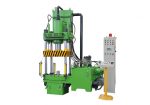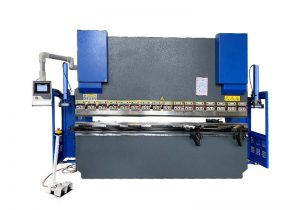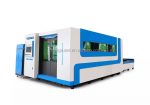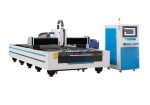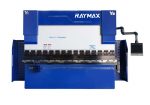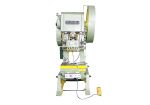What is a torsion bar press brake?
A torsion bar press brake is a machine tool that is used for bending sheet metal and plate. It consists of a bed, a ram, and a torsion bar. The bed is a horizontal platform that supports the sheet metal being bent. The ram is a vertical part that moves up and down, and it has a tool attached to the bottom called a punch. The torsion bar is a long, flexible rod that is mounted horizontally above the bed. When the ram moves down, it pushes the punch against the sheet metal, and the torsion bar twists, creating a bending force. The torsion bar press brake is controlled by a hydraulic or mechanical system, which allows the operator to adjust the bending force and angle.
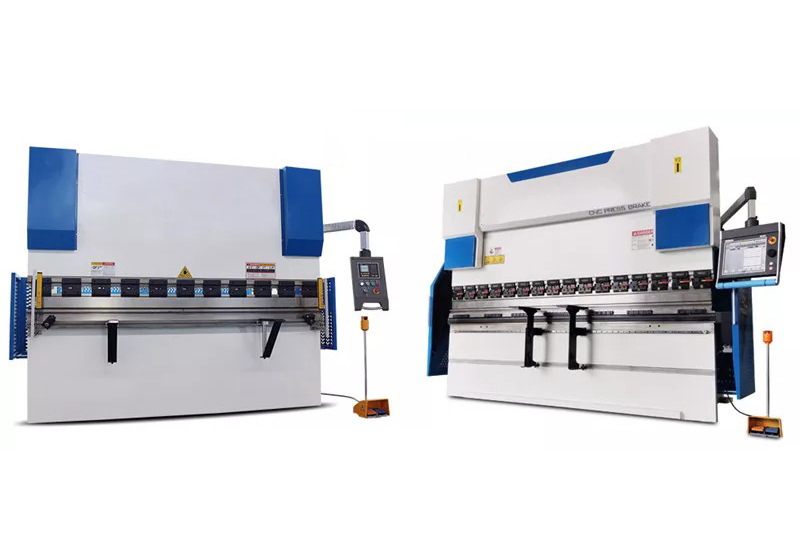
How does a torsion bar press brake work?
A torsion bar press brake works by using a torsion bar to generate a bending force on a piece of sheet metal or plate. The torsion bar is a long, flexible rod that is mounted horizontally above the bed of the press brake. When the ram of the press brake moves down, it pushes a punch against the sheet metal, causing the torsion bar to twist. This twisting motion creates a bending force on the sheet metal, causing it to bend along a predetermined line.
The torsion bar press brake is controlled by a hydraulic or mechanical system, which allows the operator to adjust the bending force and angle. The operator sets the desired bending angle and force on the control panel, and the press brake automatically adjusts the position of the ram and the punch to achieve the desired bend. The sheet metal is clamped in place on the bed of the press brake to hold it steady during the bending process.
What are the advantages of using a torsion bar press brake?
There are several advantages to using a torsion bar press brake:
High accuracy:
Torsion bar press brakes are known for their high accuracy, which is important for producing high-quality, consistent parts.
High speed:
Torsion bar press brakes can operate at high speeds, making them efficient for mass production.
High repeatability:
Torsion bar press brakes have good repeatability, meaning that they can consistently produce parts that meet the same specifications.
Versatility:
Torsion bar press brakes can be used to bend a wide range of materials, including aluminum, stainless steel, and mild steel, and they can be used to produce a variety of parts with different shapes and sizes.
Durability:
Torsion bar press brakes are built to last and can handle high levels of stress, making them suitable for heavy-duty applications.
Ease of use:
Torsion bar press brakes are easy to operate, and they can be programmed to perform a variety of bending operations with just a few simple inputs.
Safety:
Torsion bar press brakes are equipped with safety features, such as guards and sensors, to protect operators and prevent accidents.
What are the limitations of a torsion bar press brake?
There are a few limitations to consider when using a torsion bar press brake:
Complex shapes:
Torsion bar press brakes may not be suitable for producing complex shapes or parts with deep bends, as the torsion bar may not be able to generate enough bending force.
Thick materials:
Torsion bar press brakes may struggle to bend very thick materials, as the torsion bar may not be able to generate enough force.
Limited bending angle:
Torsion bar press brakes may have a limited range of bending angles, depending on the design of the machine.
Cost:
Torsion bar press brakes can be expensive to purchase and maintain, especially for large or complex operations.
Space requirements:
Torsion bar press brakes can be large and heavy, and they may require a dedicated space for installation and operation.
How is the bending force of a torsion bar press brake determined?
The bending force of a torsion bar press brake is determined by the size and strength of the torsion bar, the position of the ram and punch, and the material being bent.
The torsion bar is the main component that generates the bending force in a torsion bar press brake. The size and strength of the torsion bar will determine how much force it can generate.
The position of the ram and punch also affects the bending force. The closer the ram and punch are to the bed of the press brake, the less force is required to bend the material. The farther apart they are, the more force is required.
The material being bent also plays a role in the bending force. Harder materials will require more force to bend than softer materials. The thickness of the material also affects the bending force, with thicker materials requiring more force to bend.
The bending force can be adjusted on a torsion bar press brake by adjusting the position of the ram and punch, or by changing the size or strength of the torsion bar. The operator can also adjust the bending force by selecting different programs or settings on the control panel.
Can a torsion bar press brake be used for complex bending operations?
It is possible to use a torsion bar press brake for complex bending operations, but it may be limited by the design of the machine and the capabilities of the torsion bar.
Torsion bar press brakes are typically used for simple bending operations, such as forming a 90-degree bend in a piece of sheet metal. They may not be suitable for more complex operations, such as forming multiple bends or producing parts with deep or irregular shapes.
That being said, some torsion bar press brakes may be equipped with advanced features and tooling that allow them to perform more complex bending operations. For example, some press brakes may have multiple axes of movement or a CNC (computer numerical control) system that allows the operator to program and execute complex bending sequences.
If you are considering using a torsion bar press brake for complex bending operations, it is important to assess the capabilities of the machine and ensure that it is suitable for your needs. It may also be necessary to use specialized tooling or techniques to achieve the desired results.
What safety precautions should be taken when operating a torsion bar press brake?
There are several safety precautions that should be taken when operating a torsion bar press brake:
- Wear proper personal protective equipment (PPE): This may include safety glasses, earplugs, and gloves.
- Follow proper lifting techniques: Use proper lifting techniques when handling heavy materials or tooling to avoid injuries.
- Keep the work area clean and organized: A cluttered work area can increase the risk of accidents.
- Follow the manufacturer's instructions: Familiarize yourself with the operation of the press brake and follow the manufacturer's instructions for safe use.
- Use proper tooling: Use the correct tooling for the job, and ensure that it is in good condition.
- Inspect the press brake regularly: Regularly inspect the press brake for any damage or wear and tear.
- Use guards and barriers: Use guards and barriers to protect operators from moving parts of the press brake.
- Use the press brake only for its intended use: Do not use the press brake for any purpose other than bending sheet metal and plate.
- Keep the press brake well-maintained: Proper maintenance is essential to the safe operation of the press brake. Follow a regular maintenance schedule and address any issues promptly.
- Follow proper emergency procedures: Familiarize yourself with the emergency shutdown procedures for the press brake and know how to stop the machine in an emergency.
How is maintenance performed on a torsion bar press brake?
Maintenance is an important aspect of keeping a torsion bar press brake in good working order. Here are some steps that should be taken to maintain a torsion bar press brake:
Follow a regular maintenance schedule:
It is important to follow a regular maintenance schedule to ensure that the press brake is operating efficiently and safely. The manufacturer's manual should provide guidelines for the frequency of maintenance tasks.
Clean the press brake:
Regularly clean the press brake to remove dirt and debris, which can accumulate on the machine and interfere with its operation. Use a cleaning solution and a cloth or brush to remove dirt from the bed, ram, and other parts of the machine.
Lubricate the machine:
Lubricate the moving parts of the press brake regularly to reduce wear and tear and improve its performance. Use the lubricants recommended by the manufacturer.
Check the hydraulic system:
If the press brake has a hydraulic system, check the oil levels regularly and replace the oil if necessary. Check for any leaks or damaged hoses and repair or replace them as needed.
Inspect the tooling:
Regularly inspect the punch and die for wear and damage, and replace them if necessary.
Check the safety features:
Regularly inspect the safety features of the press brake, such as guards and barriers, to ensure that they are functioning properly.
Test the machine:
Regularly test the machine to ensure that it is operating correctly. This may include running a test bend or performing a diagnostic check on the control panel.
Keep records:
Keep detailed records of all maintenance tasks, including the date of maintenance, the parts that were replaced, and any issues that were identified. This will help to track the maintenance history of the machine and identify any patterns of wear or problems.
What are the common causes of problems or failures in a torsion bar press brake?
There are a number of potential problems or failures that can occur in a torsion bar press brake. Here are some common causes of problems or failures:
Wear and tear:
The moving parts of the press brake are subjected to a lot of stress, and they can wear out over time. This can lead to problems such as reduced accuracy, reduced speed, and increased downtime.
Hydraulic issues:
If the press brake has a hydraulic system, problems such as leaks, clogs, or low oil levels can cause problems.
Electrical issues:
Electrical problems, such as faulty wiring or damaged control panels, can cause the press brake to malfunction.
Poor maintenance:
Neglecting to maintain the press brake can lead to problems such as worn or damaged parts, dirty or contaminated hydraulic oil, and reduced performance.
Improper operation:
Using the press brake improperly or beyond its capacity can lead to problems, such as damage to the machine or parts, or safety issues.
Incorrect tooling:
Using the wrong tooling or tooling that is worn or damaged can cause problems with the press brake.
Overloading:
Overloading the press brake by attempting to bend materials that are too thick or hard can cause problems with the machine or result in poor-quality parts.
Inaccurate programming:
If the press brake is programmed incorrectly, it can lead to problems such as inaccurate bends or faulty parts.
Environmental factors:
External factors, such as temperature extremes or exposure to moisture, can affect the performance of the press brake.
How do you troubleshoot issues with a torsion bar press brake?
Here are some steps you can take to troubleshoot issues with a torsion bar press brake:
Check the control panel:
Check the control panel for any error messages or codes that may indicate the source of the problem. Consult the manual or contact the manufacturer for guidance on how to interpret the messages.
Inspect the machine:
Visually inspect the press brake for any obvious problems, such as damage, wear, or debris. Check for loose bolts or other issues that may be causing problems.
Check the hydraulic system:
If the press brake has a hydraulic system, check for issues such as low oil levels, leaks, or clogs.
Check the tooling:
Inspect the punch and die for wear or damage, and replace them if necessary.
Check the material being bent:
Make sure that the material being bent is suitable for the press brake and that it is not too thick or hard for the machine to handle.
Check the programming:
Review the program being used and make sure that it is correct and that all of the settings are correct.
Consult the manual:
If you are unable to identify the problem, consult the manual or contact the manufacturer for guidance.
Consider hiring a professional:
If you are unable to troubleshoot the problem on your own, consider hiring a professional service technician to diagnose and fix the issue.
Keep records:
Keep detailed records of the problems you are experiencing and the steps you have taken to troubleshoot them. This can help you identify patterns or recurring issues and take preventative measures to avoid them in the future.
How do you choose the right torsion bar press brake for your application?
Here are some factors to consider when choosing the right torsion bar press brake for your application:
Material:
Consider the type and thickness of the material you will be bending. Different press brakes are designed to handle different materials and thicknesses, so it is important to choose a machine that is suitable for your needs.
Bending force:
Determine the amount of bending force you will need based on the material and the type of parts you will be producing. Choose a press brake that is capable of generating the required bending force.
Accuracy:
Consider the level of accuracy you need for your parts. Higher accuracy may be required for more complex or critical applications.
Speed:
Consider the production rate you need to achieve. Choose a press brake that can operate at the necessary speed to meet your production goals.
Size:
Consider the size of the parts you will be producing and the space you have available for the press brake. Choose a machine that is appropriate for the size of your parts and fits in the available space.
Features:
Consider the features you need, such as multiple axes of movement, a CNC control system, or specialized tooling. Choose a press brake that has the features you need for your application.
Budget:
Consider your budget and choose a press brake that is within your price range. It may be necessary to compromise on some features or capabilities in order to stay within budget.
Service and support:
Consider the level of service and support offered by the manufacturer or supplier of the press brake. Choose a company that is responsive and able to provide the support you need.

